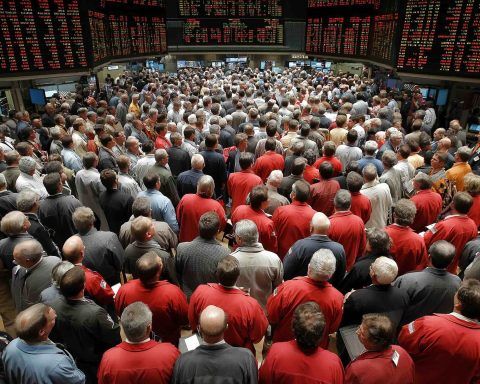On 24 November 2025, US Treasury bonds saw trading volumes surge about 75% while offshore investors rotated out of South African government bonds and into JSE-listed equities. Here’s what today’s flows say about risk sentiment, yields and the outlook for 2026.
- US Treasury bonds are in the spotlight today, with trading volume up roughly 75% versus recent norms, reflecting a powerful rush into perceived safe assets. [1]
- Benchmark 10‑year US yields are hovering near 4.0%–4.1%, easing slightly on the day as the 2025 bond rally puts Treasuries on track for their best year since 2020. [2]
- In South Africa, offshore investors just flipped from buying bonds to selling them—they sold about R11.8 billion of bonds while buying roughly R1.7 billion of JSE stocks over the past week, according to data released today. [3]
- The split highlights a global preference for US dollar safety at the sovereign level, while selective risk-taking continues in emerging‑market equities.
1. What happened today in US Treasury markets?
A 75% surge in Treasury trading
AI-driven data platform Meyka reports that US Treasury bond trading volumes jumped around 75% today, 24 November 2025, compared with normal activity levels. [4]
The Meyka coverage frames the move as:
- A reaction to global economic uncertainty
- A sign that investors are rotating toward lower‑risk, income‑generating assets
- A signal that markets are repositioning ahead of key inflation and Federal Reserve decisions in December [5]
In other words, investors who were comfortable riding risk assets through much of 2025 are now adding duration and safety as the year’s final data and central‑bank decisions approach.
Yields drift lower as prices rise
The spike in activity comes against the backdrop of a broader 2025 bond rally:
- The US 10‑year Treasury yield is trading near 4.05%–4.10% today, slightly lower than Friday’s close. [6]
- Data providers such as TradingEconomics and YCharts show that’s below its long‑term average of about 4.25% and below levels seen earlier this year, when markets briefly feared a renewed march toward 5%. [7]
Bloomberg notes that the 2025 Treasury rally has already made this Treasuries’ best year since 2020, with yields grinding back toward 4% after spiking earlier in the cycle. [8]
Put simply: prices are up, yields are down, and volumes are suddenly very heavy—a classic late‑cycle combination when investors start to hedge against economic or policy surprises.
2. Why are Treasuries suddenly so busy?
Rate‑cut hopes front and center
In its “Morning Bid” column today, Reuters highlights that global risk sentiment is being driven by hopes of a Federal Reserve rate cut in December. Investors are leaning into the idea after comments from key policymakers that cuts could be coming “in the near term,” which markets interpreted as dovish. [9]
That matters for Treasuries because:
- Lower expected policy rates increase the appeal of locking in current long‑term yields (~4% on the 10‑year).
- If the Fed cuts and inflation continues to drift lower, today’s yields could look attractive in hindsight.
- Rate‑cut pricing also steepens parts of the curve, encouraging positioning in intermediate and long‑dated bonds.
A recent Reuters poll of more than 50 bond strategists underscores this dynamic: they expect the 10‑year yield to rise only modestly from around 4.09% to roughly 4.1%–4.2% over the next year, assuming no fresh inflation shock. [10]
That’s a far cry from the 5%+ fears that briefly dominated early‑2025 options markets. [11]
Flight to safety after a volatile year in risk assets
The Meyka analysis points to geopolitical tensions, patchy growth data and lingering inflation worries as key reasons why investors are crowding into Treasuries. [12]
At the same time:
- Bloomberg notes that volatility in stocks and crypto last week sent fresh demand into Treasuries, reinforcing the safe‑haven narrative. [13]
- Commentators at Barron’s describe the yield curve flattening again today, with 10‑year yields easing while 2‑year yields edge higher—a classic sign of markets balancing near‑term rate‑cut hopes against longer‑term fiscal and inflation risks. [14]
In short, 24 November marks an inflection day where macro uncertainty meets attractive yields, and global investors are voting with their order tickets.
3. Meanwhile in Johannesburg: foreigners sell bonds, buy stocks
Today’s JSE flow data
While US Treasuries enjoy a surge in demand, South Africa is seeing the opposite move in its bond market.
Fresh data published today by Reuters (via TradingView and regional platforms) show that, over the past week:
- Offshore investors bought a net R1.67 billion of South African equities, according to Johannesburg Stock Exchange (JSE) statistics.
- Over the same period, they sold a net R11.76 billion of South African bonds, based on settlement data. [15]
This is a sharp reversal from earlier in November, when non‑resident investors were net sellers of around R4.1 billion of JSE stocks but net buyers of roughly R10 billion of local bonds. [16]
A year of big inflows into SA bonds
Zooming out, 2025 has actually been a strong year for South African government debt overall:
- Local analysis in early November estimated around R77 billion of foreign purchases of SA government bonds in August and September, the largest two‑month buying spree in at least three decades. [17]
- Earlier reports highlighted that foreigners were net buyers of more than R20 billion in JSE‑listed bonds in Q2 2025, attracted by high real yields and improving fiscal optics. [18]
But today’s weekly JSE data suggest a tactical pivot: after months of favouring South African bonds, offshore investors are now banking gains on fixed income and rotating into SA equities instead.
4. Why are investors buying US bonds but selling South African ones?
Today’s cross‑border flows highlight a nuanced picture rather than a simple “risk‑on vs risk‑off” story.
4.1 Different roles in a global portfolio
For many international investors:
- US Treasuries are the ultimate reserve asset—a core building block for liquidity, collateral and capital preservation.
- South African bonds and equities sit firmly in the “risk” bucket, offering high yields and growth exposure but with currency and political risk attached.
So a portfolio manager can plausibly:
- Increase holdings of US Treasuries to hedge macro and policy risk.
- Simultaneously trim exposure to higher‑beta EM bonds, such as South Africa’s, which are more sensitive to risk‑off spikes and local fiscal worries.
- Rotate into South African equities, which benefit from stronger commodity prices, company‑specific stories and a slightly cheaper currency.
That appears to be exactly what this week’s JSE data show: equity inflows, bond outflows.
4.2 Yield math and currency risk
South African government bonds still offer very high nominal and real yields compared with US Treasuries, which is why foreigners bought tens of billions of rand of SAGBs earlier in 2025. [19]
But investors also have to weigh:
- The risk of rand depreciation if global risk appetite sours again.
- Concerns about South Africa’s fiscal trajectory, even after some positive news on tax receipts and state‑owned enterprises. [20]
- The fact that US yields around 4% now come with a credible prospect of Fed cuts, reducing the relative penalty for holding “safer” US paper. [21]
For some global funds, it’s rational to take profit on South African bonds after a “scary good” year, as one local strategist recently described it, and redeploy part of that capital into:
- US Treasuries for safety, and
- South African or other emerging‑market equities for growth.
4.3 Tactical versus structural moves
It’s also important to distinguish between:
- Structural demand for South African bonds (for example, from local banks and asset managers who like the high real yields).
- Tactical offshore flows, which can swing sharply week to week as global macro headlines shift.
Today’s numbers largely capture the latter. Local buyers can still absorb much of the foreign selling, especially when yields have moved to levels they view as attractive.
5. What this means for investors and policymakers
Nothing here is personal investment advice. It’s a news‑style overview of today’s moves and the factors behind them.
5.1 For global fixed‑income investors
- Treasuries look increasingly central again: With 10‑year yields near 4% and markets pricing in rate cuts, US government bonds are reclaiming their role as a core building block in global portfolios. [22]
- Volatility is here to stay: Heavy volumes and a 75% activity spike signal that investors are still repositioning aggressively, not sitting still. [23]
- Curve signals matter: A flatter curve—2‑year yields sticky, 10‑year yields easing—suggests markets expect slower growth, modest inflation and policy easing, but remain wary of longer‑term fiscal risks. [24]
5.2 For South African assets
- Bond investors face a more nuanced environment: After months of inflows and strong returns, foreign money is no longer a one‑way support for SAGBs. Weekly data show that offshore flows can flip from strong buying to heavy selling within a fortnight. [25]
- Equities are regaining foreign interest: The latest JSE figures show offshore investors back on the buy side for local stocks, potentially supporting valuations if global risk appetite holds. [26]
- The rand remains a key swing factor: Currency moves will determine whether dollar‑based investors view South African returns as compelling or not, especially if the Fed’s path diverges from SA Reserve Bank policy.
5.3 For policymakers
Today’s moves also carry messages for policymakers in Washington and Pretoria:
- For the US Treasury and Federal Reserve, strong demand for Treasuries at current yields suggests investors still trust the US as the world’s primary safe asset—but also that markets are highly sensitive to communication about future cuts and debt issuance. [27]
- For South Africa’s National Treasury and the Reserve Bank, the flow reversal underscores the importance of credible fiscal consolidation and inflation control—key ingredients to keep foreign buyers engaged in the bond market after 2025’s big inflow wave. [28]
6. What to watch after 24 November 2025
Looking beyond today’s headlines, several catalysts will determine whether the Treasury rally and South African flow reversal persist:
- Federal Reserve’s December meeting
- Markets are pricing a meaningful chance of a rate cut. Any surprise—hawkish or dovish—could trigger another big move in both US and EM yields. [29]
- Upcoming US inflation and employment data
- Softer data would likely reinforce demand for Treasuries, while upside surprises could push the 10‑year back above recent ranges.
- South African fiscal and political developments
- Investors will track budget updates, state‑owned‑enterprise reforms and ratings commentary closely, especially after this year’s surge in foreign bond buying.
- Global risk sentiment and commodity prices
- As a commodity‑linked emerging market, South Africa’s equity and bond performance is tightly linked to metals prices and broader EM risk appetite—factors that also shape how “safe” Treasuries feel by comparison.
Bottom line:
On 24 November 2025, global capital is sending a clear message. US Treasuries are back in demand as the world’s safety anchor, with trading volume surging 75% and yields drifting toward 4%. At the same time, offshore investors are selectively taking chips off the table in South African bonds, redeploying some of that capital into JSE stocks instead.
For anyone watching the intersection of developed‑market rates and emerging‑market risk, today’s flows are a reminder: in the late stages of a tightening cycle, it’s not just how high yields are—it’s where investors feel safest earning them.
References
1. meyka.com, 2. tradingeconomics.com, 3. www.tradingview.com, 4. meyka.com, 5. meyka.com, 6. tradingeconomics.com, 7. ycharts.com, 8. www.bloomberg.com, 9. www.reuters.com, 10. www.reuters.com, 11. www.reuters.com, 12. meyka.com, 13. www.bloomberg.com, 14. www.barrons.com, 15. www.tradingview.com, 16. www.tradingview.com, 17. dailyinvestor.com, 18. www.sagoodnews.co.za, 19. dailyinvestor.com, 20. www.sagoodnews.co.za, 21. www.reuters.com, 22. tradingeconomics.com, 23. meyka.com, 24. www.barrons.com, 25. www.tradingview.com, 26. www.tradingview.com, 27. www.bloomberg.com, 28. dailyinvestor.com, 29. www.reuters.com










